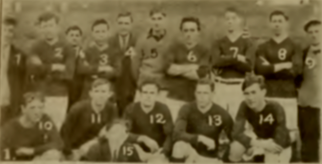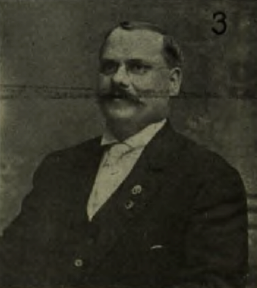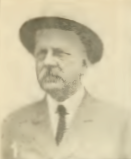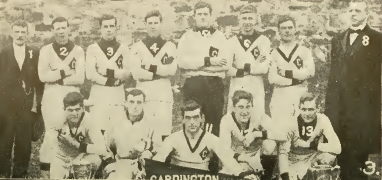One hundred years ago, league soccer in America was strictly a fall through winter sport. But while no league games took place in Philly in over the summer of 1913, there was plenty going on in the local soccer scene.
Summer friendlies
Despite the summer break from league play, area teams still got together for summer friendlies, particularly during summer gatherings of the city’s English, Irish, and Scottish ethnic associations.
Such gatherings have an important place in early Philadelphia soccer history, with what is possibly the first recorded soccer game in the city happening at the Irish Nationalists annual picnic on June 26, 1871 at Oakdale Park. The park, which was located in West Kensington at 11th and Cumberland, is otherwise known to Philadelphia sports history for its baseball connections as the site of amateur games after the end of the Civil War and later the home of the Philadelphia Athletics in the team’s 1882 inaugural season.
In 1913, the summer season of friendlies began with a soccer celebration at Washington Park on the Delaware, which was located just across the river from Philadelphia in what is now Westville, NJ, the grounds of which later became the site of the Eagle Point refinery.
First opened in 1895 and featuring such attractions as an all-female orchestra, one of the largest Ferris wheels in the world, a “shoot-the-chutes” water ride, the largest beach on the Delaware, an Electric fountain, and much more, Washington Park was a popular destination for area residents looking for a summer day-trip, with ferries running from Philadelphia and a trolley line from Camden.
On June 21, 1913, the park’s athletic grounds were the attraction for local soccer fans who gathered for a “monster carnival of five-a-side contests” between teams from the city’s American, United, Northeast Junior, and Philadelphia Junior Leagues. Also on hand were teams from Swarthmore and Eddystone, as well as two teams from Reading that brought “about two hundred rooter with them.” The Inquirer reported that, all told, some two thousand spectators were on hand for the games, even with the appearance of rain later in the afternoon.
The games commenced at 2 pm and continued for more than five hours, with the final contest being played in the dark. Celtic won the Junior Leagues tourney and Holdfield won the United League honors. Reading won the American League title.
The Pennsylvania League’s Thistle and Athletics clubs met for the final match of the day. The Inquirer reported on June 22, “These teams played three periods without either team scoring and during an argument the referee ordered one of the Athletic players from the field and it was decided to play it off on the Fourth of July. ”
Although I can find no record of whether the rubber game between Thistle and Athletics took place, on July 12, Thistle and Tacony played an exhibition game at the Loyal Orange Institution’s picnic at Central Park, located at 4400 North Fifth Street. Some 14,000 men, women, and children took part in the parade through Kensington that preceded the picnic so there must have been quite a crowd on hand for the game. Interestingly, the Orangemen held two picnics on that day, with the picnic at Central Park serving alcohol and another picnic at Philadelphia’s Washington Park at 26th and Allegheny serving only soft drinks. The dry picnic was attended by about two thousand celebrants.
On August 2, the Sons of St. George held their annual English Games at Washington Park on the Delaware in which the main event was a match between West Philadelphia and Cardington.
While the city’s several leagues would not start play until the beginning of October, a Labor Day friendly on September 1 between Hibernians and Tacony at Second and Allegheny was advertised as the ‘opening game of the season.” Hibs was the winner.
Numerous preseason friendlies continued throughout September in the lead up to the start of league play, including another five-a-side tournament on Sept. 20 that was organized by the Trenton Caledonian Soccer Club. The first place prize was five soccer kit bags, the second place team receiving five “silver-mounted umbrellas.”
An inter-city friendly also took place on Sept. 20, with Brooklyn Field Club traveling south to play Tacony. The visitors proved to be the victor, defeating Tacony 2-0.
Leagues to band together
The 1912-1913 season had been one of the best for organized games in the sport’s history in Philadelphia, the Inquirer reporting on June 1, “Never before, in the writer’s estimation, has the game progressed in any one season to such an extent as it did last season, and it looks as if soccer football has at last gained a footing that speaks volumes of success for the future welfare of the game in this city and vicinity.”
This success led the Inquirer to report on July 6 that a movement was underway by the heads of the American League, the United League, Northeast Junior League, and Philadelphia Junior League to combine under one organizing body. The Inquirer described, “According to the plans of those involved in the movement, the four leagues will work in harmony together, but will retain their titles.” The Inquirer continued, “Should this quartet band together they will form the strongest organization in the country and would be in a position to dictate anything appertaining to soccer football in this city.”
National soccer organization takes shape
The impetus to organize was perhaps a reaction of larger movements on the national soccer scene. Philadelphia soccer leaders had been instrumental in the founding of the United States of America Football Association, known to today as the US Soccer Federation, in April of 1913. On June 23, the Inquirer reported that Oliver Hemingway of the city’s Allied American League had been elected first vice president president of the new national soccer association.
The same day, the Inquirer reported the organization of the Eastern Pennsylvania and District Football Association, the body that would be affiliated with the USFA for the purpose of governing the sport locally. Alfred Frost, who along with Hemingway had been so important in getting the national body off the ground, would be the association’s first president.
The Inquirer endorsed the founding of the local organizing body while acknowledging the concerns of some about possible conflicts of interest because several of the association’s officers were also officers of some of the leagues they would govern. The Inquirer wrote on August 4, “If the Eastern Association is governed properly without fear or favor, it will prove a boon to the sport for there is no gainsaying the fact that soccer, practically ever since it was first introduced into this city, has been governed in a manner that has not helped the game any.”
One of the first actions of the Eastern Association leadership was to institute yearly fees for member leagues. The Inquirer described on July 15 that fees would be as follows: “Professional leagues: $2 per club; amateur leagues: $1 per club; junior amateur leagues: 50 cents per club and independent teams not affiliated with any league $2 per club.” In 1913, $2 was the equivalent of $47.25.
The main competitor for the USFA to the claim of being soccer’s national governing body had been the American Football Association, originally founded in 1884 and the organizer of the American Cup tournament which, before the establishment of the first National Challenge Cup tournament in 1913-14 — known today as the US Open Cup — was the closest thing to a national championship for soccer. Any hope within the AFA that it would claim the title of the supreme governing body of the sport ended when FIFA granted the USFA provisional membership on August 15. Two days later, the AFA voted to affiliate with the USFA.
It is interesting to note that two important rule changes were approved by the International Football Association Board in the summer of 1913. On June 30, the Inquirer reported that players would now have to stand at least 10 yards from the spot of a free kick. Previously, the rule had been that players had to stand six yards from the spot of a free kick. The IFAB had also decided that goalkeepers were now forbidden from handling the ball outside of the penalty area. Two proposed rule changes backed by the Scottish FA — amending the offside rule so that a player would be onside if two defenders were in front of the ball at the moment of kicking or throwing it instead of the three as stated by the existing rule, and requiring that fields be at least 55 yards wide instead of 50 — were not adopted but apparently “created quite a lot of discussion.”
The curious case of Cardington and the Cup
The authority of the Eastern Association was soon challenged when Delaware County’s Cardington FC, then a member of the city’s American League, refused to return the cup it had won two years earlier as champions of the now defunct Philadelphia and Suburban League. After receiving a complaint from the Allied American League, the Eastern Association decided at a meeting on Sept. 8 that Cardington would be disenfranchised until it returned the cup. The Inquirer reported on Sept. 14 that the American League had decided at a meeting two days before to back Cardington in refusing to return the cup. It was a decision based on procedural grounds: Cardington argued that they had not been asked to return the cup by the Eastern Association before it voted to suspend the club in response to the complaint from the Allied League.
On Sept. 15, the Inquirer reported that “it looks as if there is more trouble brewing in the near future” because, in addition to voting to back Cardington, the American League “also practically intimated that under no consideration would they submit to the recent ruling of the State organization in suspending Cardington.” The Inquirer noted that while it “was not in sympathy with the action that the American League decided upon…it is, nevertheless, tough on Cardington that the Eastern Magnates suspended the club without giving them the chance to present their side of the case.” Acknowledging that it had supported the Eastern Association upon its founding little more than two months before, the Inquirer nevertheless expressed its concern that “such strong arm tactics from the association is bad noise and is apt to create disruption in the ranks of organized soccer.”
It was thus with some relief that the Inquirer could report on Sept. 21 that Cardington had returned the cup to the Eastern Association and “now that they have fulfilled all obligations their suspension will be lifted and the team allowed to play its schedule in the American League series.”







good stuff. that cardigan team looked like trouble anyway
*cardington* stupid phone
Great stuff, Ed! 🙂